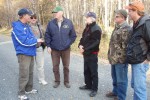The results of an inspection are in for three roads that are part of a demonstration project for chipseal. On roads with low traffic volume, chipseal is the way to go.
“The Mat-Su has so many miles of gravel roads, and people are tired of dust and washboarding,” said Billy Connor, Director of Alaska University Transportation Center. “The million dollars a mile for asphalt, you just can’t afford it. With chipseal you buy a product that can serve your needs and be cost effective.”
Nearly seven hundred miles of public gravel roads are in the Borough. Chipseal, at $140,500 per mile, costs much less than the traditional pavement of asphalt cement at $250,000 per mile. On top of that, asphalt cement requires expensive road preparation, upping the costs to about $1 million per mile.
“This year’s projects were excellent,” Connor said, who evaluated the performance of the chipseal roads. “The quality of the work this year was as good as it gets.”
Three roads were treated this year as part of the project.
• Hidden Hills Road in the Caswell Lakes area
• Roberts Road in Willow
• Willow Senior Housing Access in Willow
“The whole demonstration project turned out to be positive,” Connor said. “Crystal Lake Road was treated two years ago. It was the only marginal one, but we knew it was marginal and wanted to set the bottom limit in what we could do.”
Crystal Lake Road is an old roadbed coping with Willow’s subzero temperatures. It will require pothole patching. The other roads might not require maintenance for 5 to 10 years.
The chipseal maintenance costs also beat out the upkeep costs for a gravel road. There’s no constant grading to remove potholes, no watering, the benefits of which last for only two to three days, and there’s no need for calcium chloride to combat the dust. This year more than $590,000 was spent in the Borough on calcium chloride.
Jim Norcross, chairman of the Greater Willow Road Service Area, is a champion of chipseal. Willow is one of 16 road service areas in the Borough. For roads outside of the three cities, the RSAs are why Borough roads get plowed, paved, and repairs such as new culverts. Property owners in each RSA pay taxes specific to their RSA for such service. And recently budgets have been tight.
“In place of asphalt it’s cutting my costs tremendously,” Norcross said. “Additionally, I can do away with dust control problems and don’t have to waste money on calcium chloride every year.”
Sen. Charlie Huggins sponsored the chipseal project with the Borough.
“Well chipseal sort of fits my personality, in the sense that you get pavement on roads that it’s appropriate for and you get a reduced cost for it and you get dust control and—oh by the way—we can do more road miles for less money. I’m just glad to be part of a process that keeps economy in mind but that accomplishes the task,” Huggins said.
Norcross said the Borough Public Works Operations and Maintenance Division made the project come to fruition.
Here are funding breakdowns:
Roberts Road –—$36,000 State funding; $36,000 Borough matching dust control, $9,000 RSA; Total $81,000
Willow Senior Access—$20,000 State funding; Float Plane Access $18,000
Hidden Hills Road - $93,000 State; $50,000 Spruce Bark Beetle Project (Federal); $163,000 Borough matching dust control; Total $306k
The Float Plane Access is also the entrance road to the Willow Senior Housing.
Photo: L to R, Billy Connor, Executive Director, Alaska University Transportation Center, Fairbanks; Jim Norcross, Willow RSA; Alaska Sen. Charlie Huggins; Chuck Kaucic, MSB DPW; Mike Lachelt, MSB DPW; Jim Jensen, MSB DPW.
For more information call Project Manager Chuck Kaucic at 745-9807 or This email address is being protected from spambots. You need JavaScript enabled to view it.
—End—


